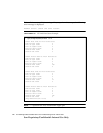
Chapter 9 Troubleshooting Virtualization Engine Devices 113
Sun Proprietary/Confidential: Internal Use Only
FC Link Error Status Report
The virtualization engine’s host-side and device-side interfaces provide statistical
data for the counts listed in
TABLE 9-4.
▼ To Check the FC Link Error Status Manually
The Storage Automated Diagnostic Environment, which runs on the Storage Service
Processor, monitors the FC link status of the virtualization engine. The virtualization
engine must be power-cycled to reset the counters. Therefore, you should manually
check the accumulation of errors during a fixed period of time. To check the status
manually, follow these steps:
1. Use the svstat command to take a reading, as shown in
CODE EXAMPLE 9-1.
A status report for the host-side and device-side ports is displayed.
2. Within the next few minutes, take another reading.
The number of new errors that occurred within that time frame represents the
number of link errors.
TABLE 9-4 Virtualization Engine Statistical Data
Count Type Description
Link failure count The number of times the virtualization engine’s frame manager
detects a nonoperational state or other failure of N port
initialization protocol.
Loss of
synchronization
count
The number of times that the virtualization engine detects a loss in
synchronization.
Loss of signal count The number of times that the virtualization engine’s frame manager
detects a loss of signal.
Primitive sequence
protocol error
The number of times that the virtualization engine’s frame manager
detects N port protocol errors.
Invalid transmission
word
The number of times that the virtualization engine’s 8-bit and 10-bit
decoder does not detect a valid 10-bit code.
Invalid cyclic
redundancy code
(CRC) count
The number of times that the virtualization engine receives frames
with a defective CRC and a valid EOF. A valid EOF includes EOFn,
EOFt,orEOFdti.


















